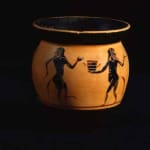Greek Attic Black-Figured Mastoid Cup, 530 BCE - 510 BCE
Terracotta
height 9.5 cm
height 3 3/4 in
height 3 3/4 in
LA.505
The ancient Greeks pioneered decorating vases in such a way that the composition of the design reflected the architectonic shape of the vessel. This aesthetic concern is seen to best...
The ancient Greeks pioneered decorating vases in such a way that the composition of the design reflected the architectonic shape of the vessel. This aesthetic concern is seen to best advantage in this cup in which the black glaze emphasizes the bottom and top of the vessel and frames the continuous band of figural decoration which unfolds around the body of the vessel. That figural band is treated as if it were a Greek Ionic frieze which continually wraps itself around the vessel in an uninterrupted manner. The principal subject is Dionysos, god of wine and the revel, who is depicted as a bearded figure, luxuriously draped in a himation, with his long hair decorated with a wreath of ivy leaves. In his outstretched left hand he holds a rhyton, a deluxe cup for drinking wine. To the left and right are figures of Maenads who frame Dionysos by moving in opposite directions. They turn their heads back and cast their glance at the god. Each Maenad wears a long chiton and has her arranged in a sakkos, a kind of Greek snood. Maenads, as the female companions of Dionysos, personified release from earthly cares brought about by wine. They were often depicted, as here, dancing in ecstasy. To that end the Maenad to the right is playing krotala, an ancient form of castanets.
This trio of figures is balanced by a second group of three figures, all satyrs. Satyrs are composite beasts who, as here, were often depicted nude with full beards, tails, horse-legs for feet, and pointed, animal ears. In Greek art, satyrs are often depicted as companions of Dionysos, and symbolize passion, not reason. The first of the satyrs moves to the left, holding another wine-drinking vessel, in his outstretched right hand. He turns his head back and gestures to one of the Maenads with his extended left hand. His two companions, moving to the right, dance energetically with feet and arms raised in the air. Such a vessel was doubtless used at symposia, or drinking parties. The complete lack of handles doubtless made it easier for its owner to hold this cup at random and easily direct it to his mouth by means of the subtle stripe of red around the vessel’s lip. Participants at such symposia not only drank to excess but also engaged in sexual activities with hatairai, versatile and often highly-educated women. The shape of this wine-drinking cup alludes to such trysts. Its shape is derived from earlier cups created by Corinthian potters which imitated the shape of a woman’s breast. And it is for that reason that the Greeks called such a cup a mastos.
Provenance Oscar Blum Gentilomo (1903-1975).
This trio of figures is balanced by a second group of three figures, all satyrs. Satyrs are composite beasts who, as here, were often depicted nude with full beards, tails, horse-legs for feet, and pointed, animal ears. In Greek art, satyrs are often depicted as companions of Dionysos, and symbolize passion, not reason. The first of the satyrs moves to the left, holding another wine-drinking vessel, in his outstretched right hand. He turns his head back and gestures to one of the Maenads with his extended left hand. His two companions, moving to the right, dance energetically with feet and arms raised in the air. Such a vessel was doubtless used at symposia, or drinking parties. The complete lack of handles doubtless made it easier for its owner to hold this cup at random and easily direct it to his mouth by means of the subtle stripe of red around the vessel’s lip. Participants at such symposia not only drank to excess but also engaged in sexual activities with hatairai, versatile and often highly-educated women. The shape of this wine-drinking cup alludes to such trysts. Its shape is derived from earlier cups created by Corinthian potters which imitated the shape of a woman’s breast. And it is for that reason that the Greeks called such a cup a mastos.
Provenance Oscar Blum Gentilomo (1903-1975).
Provenance
Oscar Blum Gentilomo, 1903-1975.Private Collection, 1975 - 2004
Christie's, Sale 1384, Lot 25, 8 June 2004



